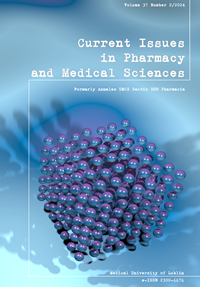The Multiple-Locus Variable Number Tandem Repeat Analysis (MLVA) of Staphylococuss aureus clinical isolates recovered from the Provincial Specialist Hospital in Lublin, Poland
DOI:
https://doi.org/10.2478/cipms-2024-0014Keywords:
genotyping, MLVA, Staphylococcus aureus, epidemiologyAbstract
Understanding the epidemiology and evolution of Staphylococcus aureus (SA) is crucial for implementing effective infection prevention and control measures. In this study, a short-term (4-month) and local molecular epidemiology of SA in the nosocomial setting was investigated using multiple-locus variable number tandem repeat (VNTR) analysis (MLVA). The study included 31 clinical SA isolates. The analysis was based on two complimentary panels encompassing 14 VNTR loci wherein a first-line assay comprised a subset of 10 loci (Panel 1), followed by a second subset of four loci (Panel 2). Thirty MLVA profiles were generated. Small amplicons were obtained for three out of the four loci included in Panel 2 for more than half of the isolates, making the calculation of the number of repeats impossible. Therefore, phylogenetic clustering was based on the analysis of basic loci included in Panel 1 (which identified two major genetic clusters). Cluster I included 26 (84%) isolates, among which 14 were classified into five sub-clusters (cutoff value ≥65%). Only one pair of the isolates shared an identical MLVA pattern. Our study indicates the usefulness of a MLVA tool comprised of a primary subset of 10 loci to track the possibility of SA intra-hospital transmission. We report a high genetic diversity of the isolates and suggest a limited degree of intra- and inter-ward SA transmission. Further genetic studies are necessary to investigate the nature of the small alleles yielded in Panel, as their subset can provide even higher resolution of the assay.
References
1. Patel H, Rawat S. A genetic regulatory see-saw of biofilm and virulence in MRSA pathogenesis. Front Microbiol. 2023;14:30.
2. Plumet L, Ahmad-Mansour N, Dunyach-Remy C, Kissa K, Sotto A, Lavigne JP, et al. Bacteriophage therapy for Staphylococcus aureus infections: a review of animal models, treatments, and clinical trials. Front Cell Infect Microbiol. 2022;12:16.
3. Lynch JP, Zhanel GG. Escalation of antimicrobial resistance among MRSA part 1: focus on global spread. Expert Rev Anti-Infect Ther. 2023;21(2):99-113.
4. Shoaib M, Aqib AI, Muzammil I, Majeed N, Bhutta ZA, Kulyar M, et al. MRSA compendium of epidemiology, transmission, pathophysiology, treatment, and prevention within one health framework. Front in Microbiol. 2023;13:30.
5. Konstantinovski MM, Veldkamp KE, Lavrijsen APM, Bosch T, Kraakman MEM, Nooij S, et al. Hospital transmission of borderline oxacillin-resistant Staphylococcus aureus evaluated by whole-genome sequencing. J Med Microbiol. 2021;70(7):9.
6. Chadi ZD, Dib L, Zeroual F, Benakhla A. Usefulness of molecular typing methods for epidemiological and evolutionary studies of Staphylococcus aureus isolated from bovine intramammary infections. Saudi J Biol Sci. 2022;29(8):14.
7. Sabat A, Malachowa N, Miedzobrodzki J, Hryniewicz W. Comparison of PCR-based methods for typing Staphylococcus aureus isolates. J Clin Microbiol. 2006;44(10):3804-7.
8. Pourcel C, Hormigos K, Onteniente L, Sakwinska O, Deurenberg RH, Vergnaud G. Improved multiple-locus variable-number tandem-repeat assay for Staphylococcus aureus genotyping, providing a highly informative technique together with strong phylogenetic value. J Clin Microbiol. 2009;47(10):3121-8.
9. Grzegorczyk A, Malm A. Genotyping of Staphylococcus aureus strains isolated from healthy persistent carriers. Folia Microbiol. 2014;59(4):349-53.
10. Sabat A, Krzyszton-Russjan J, Strzalka W, Filipek R, Kosowska K, Hryniewicz W, et al. New method for typing Staphylococcus aureus strains: multiple-locus variable-number tandem repeat analysis of polymorphism and genetic relationships of clinical isolates. J Clin Microbiol. 2003;41(4):1801-4.
11. Karynski M, Sabat AJ, Empel J, Hryniewicz W. Molecular surveillance of methicillin-resistant Staphylococcus aureus by multiple-locus variable number tandem repeat fingerprinting (formerly multiple-locus variable number tandem repeat analysis) and spa typing in a hierarchic approach. Diagn Microbiol Infect Dis. 2008;62(3):255-62.
12. Malachowa N, Sabat A, Gniadkowski M, Krzyszton-Russjan J, Empel J, Miedzobrodzki J, et al. Comparison of multiple-locus variable-number tandem-repeat analysis with pulsed-field gel electrophoresis, spa typing, and multilocus sequence typing for clonal characterization of Staphylococcus aureus isolates. J Clin Microbiol. 2005;43(7):3095-100.
13. Schouls LM, Spalburg EC, van Luit M, Huijsdens XW, Pluister GN, van Santen-Verheuvel MG, et al. Multiple-locus variable number tandem repeat analysis of Staphylococcus aureus: comparison with pulsed-field gel electrophoresis and spa-typing. PLOS ONE. 2009;4(4):13.
14. Sobral D, Schwarz S, Bergonier D, Brisabois A, Fessler AT, Gilbert FB, et al. High throughput Multiple Locus Variable Number of Tandem Repeat Analysis (MLVA) of Staphylococcus aureus from human, animal and food sources. PLOS ONE. 2012;7(5):11.
15. Hardy KJ, Oppenheim BA, Gossain S, Gao F, Hawkey PM. Use of variations in staphylococcal interspersed repeat units for molecular typing of methicillin-resistant Staphylococcus aureus strains. J Clin Microbiol. 2006;44(1):271-3.
16. Francois P, Huyghe A, Charbonnier Y, Bento M, Herzig S, Topolski I, et al. Use of an automated multiple-locus, variable-number tandem repeat-based method for rapid and high-throughput genotyping of Staphylococcus aureus isolates. J Clin Microbiol. 2005;43(7):3346-55.
17. Su YC, Hung WW, Lin JM, Chang CC, Chen YH, Lai YL, Tseng SP, Lu PL, Yamamoto T, Teng LJ, Hung WC. Tracking the evolution of the two successful CC59 methicillin-resistant Staphylococcus aureus clones in Taiwan: the divergence time of the two clades is estimated to be the 1980s. Int J Antimicrob Agents. 2020; 56(2):106047.
18. Cramton SE, Schnell NF, Götz F, Brückner R. Identification of a new repetitive element in Staphylococcus aureus. Infect Immun. 2000;68(4):2344-8.
Downloads
Published
Issue
Section
License
Copyright (c) 2024 Authors

This work is licensed under a Creative Commons Attribution-NonCommercial-NoDerivatives 3.0 Unported License.


